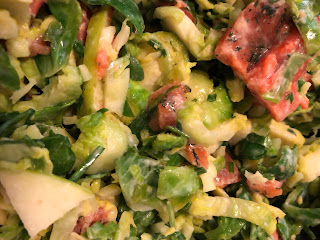Hot out of the oven, and with a beautiful dark brown color
to the skin. My mouth is watering! Can't hardly wait for them to
cool enough so I can cut into them!
Add salt to a measuring cup.
Pour in the buttermilk.
Stir until the salt is dissolved in the buttermilk.
Put the seasoned chicken in a gallon size Ziplock bag,
pour over the chicken, the salted buttermilk.
I prepared two chickens, so I set them together in a baking dish
to put in the refrigerator for 24 hours.
In the morning I flipped the chickens, so both sides would be
equally marinated.
Remove the chicken from the bag of marinade, and let the excess
buttermilk drip off a bit. Place in a roasting pan,
and tie up the legs.
I have been wanting to try the recipe, and I was not disappointed!
It turned out so moist. I took the chickens out of the oven
after one hour of baking, the temperature was 155 degrees,
tent it and let it rest, in the additional 10-15 minutes it rests,
the temperature of the chicken continues to rise, and it reaches
the recommended 165 degrees internal temperature for the thigh.
As Always,
ENJOY!
Recipe Source: Salt Fat Acid Heat by Samin
3 1/2 - 4 lb. Roasting Chicken
Kosher salt and sea salt
2 cups buttermilk
The day before you want to cook the chicken, remove the wingtips by cutting through the first wing joint with poultry shears or a sharp knife. Reserve for stock. Season the chicken generously with salt and let it sit for 30 minutes.
Stir 2 tablespoons of kosher salt or 4 teaspoons fine sea salt into the buttermilk to dissolve. Place the chicken in a gallon-size resealable plastic bag and pour in the buttermilk. If the chicken won’t fit in a gallon-size bag, double up two plastic produce bags to prevent leakage and tie the bag with a piece of twine.
Seal it, squish the buttermilk all around the chicken, place on a rimmed plate, and refrigerate. If you’re so inclined, over the next 24 hours you can turn the bag so every part of the chicken gets marinated, but that’s not essential.
Pull the chicken from the fridge an hour before you plan to cook it. Preheat the oven to 425°F (220°C), with a rack set in the center position.
Remove the chicken from the plastic bag and scrape off as much buttermilk as you can without being obsessive. Tightly tie together the legs of the chicken with a piece of butcher’s twine. Place the chicken in a 10-inch cast iron skillet or shallow roasting pan.
Slide the pan all the way to the back of the oven on the center rack. Rotate the pan so that the legs are pointing toward the rear left corner and the breast is pointing toward the center of the oven (the back corners tend to be the hottest spots in the oven, so this orientation protects the breast from overcooking before the legs are done). Pretty soon you should hear the chicken sizzling.
After about 20 minutes, when the chicken starts to brown, reduce the heat to 400°F and continue roasting for 10 minutes and then move the pan so the legs are facing the back right corner of the oven.
Continue cooking for another 30 minutes or so, until the chicken is brown all over and the juices run clear when you insert a knife down to the bone between the leg and the thigh.
When the chicken’s done, remove it to a platter and let it rest for 10 minutes before carving and serving.



















